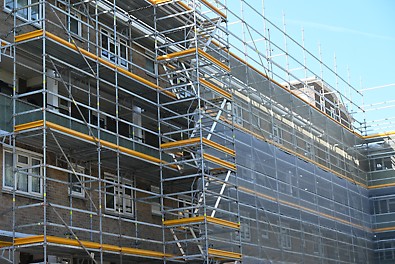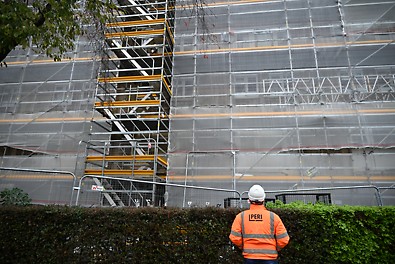
Situated in West London, Treadgold House is a 4-storey residential estate undergoing refurbishment to provide residents with a more thermally efficient building.
The work involves replacing existing waterproofing coverings, windows and balconies from the building. Two temporary roofs have been installed to protect from rain as the current layers are stripped and replaced with energy-efficient material.
Although both roofs have been constructed in tube and fitting, scaffolding requirements for façade access have been more stringent. The facade access around both buildings is built entirely out of system scaffolding as per the material specification provided by the local council. Next Generation Scaffolding Ltd was tasked with installing both the temporary access and the roofs.
Mitigating the use and risk of combustible materials was a top priority during the refurbishment. This was especially important given the context of widespread remedial façade works on mid to high-rise buildings across the country. To meet this requirement, the PERI UP scaffolding system was specified for the project due to its all-metal design inclusive of its decks and toeboards.


By integrating different systems in the PERI UP range, design consultant Double Scaffold Design was able to catalyse the assembly process and reduce strain on scaffolders during material handling.
PERI UP Easy decks were used for the main scaffolding platforms due to their lightweight, while PERI UP Flex was used on the inside brackets to cover any gaps where the façade steps back.
PERI UP was also designed to blend effortlessly with non-system components on this project, such as tube and fitting for the roof structure and the beam work on the building’s east elevation to enable vehicle access.
Using system scaffolding instead of tube and fitting for the façade access requirements provided a clear walkway for Next Generation Scaffolding on each level, as ledger braces did not need to be installed.
The solution was praised by the scaffolding contractor for its flexibility and wide range of components.
The scaffolding structure is expected to be in place until May 2024. In addition to installing new waterproofing and non-combustible insulation, the temporary access will facilitate solar panel installation and an air source heat pump on the roof.
